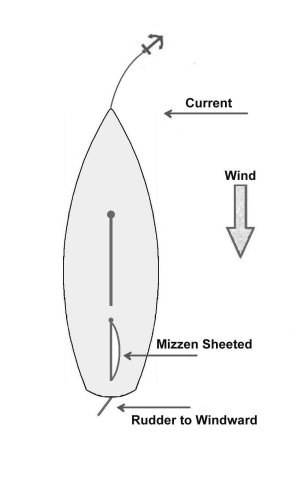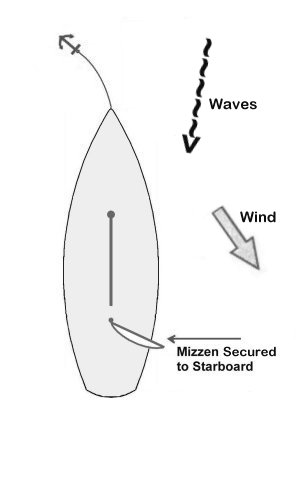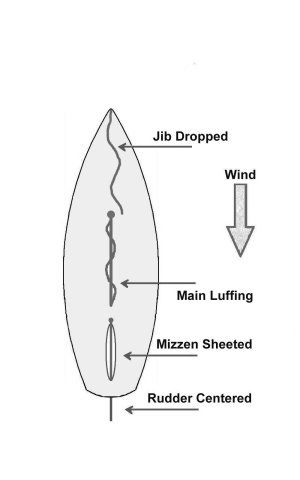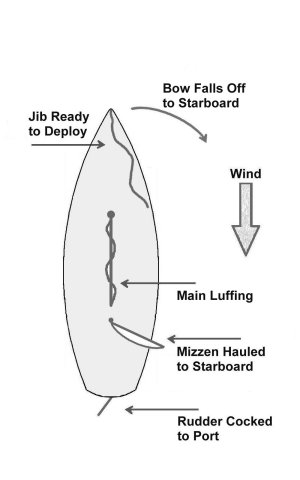THE AMAZING MIZZEN
©
2010 Tor Pinney - All Rights Reserved

~~~~~~~~~~~~~~~~~~~~~~~~~~~~~~~~ |
Ketches and yawls are not as common as they once were.
Still, mizzens have been around for a long time and with
good reason. A mizzen sail can be useful in ways that many
modern sailors don't realize. Positioned so far aft, this
little workhorse acts as a big wind rudder, pushing the
stern away from the wind and forcing the bow the opposite
way.
There are occasions when this can be particularly useful.
The
Riding Sail
When
anchored in a gentle crosscurrent, a boat may turn
broad or even broadside to the wind. This can be inconvenient if the sea
is rocking the boat or if you want the breeze to flow
through the hatches.
With
a mizzen it’s easy to bring the bow into the wind. Hoist
the mizzen sail and sheet it in hard. As long as there is
sufficient breeze, the "wind rudder" effect will overcome
a moderate current and head the boat into the wind and sea.
Cocking the rudder to windward will help, too. (See Figure
1)
Even
in normal anchorage conditions, holding the bow
steadfastly into the wind reduces strain on the rode
and anchor compared to a vessel that yaws or "sails at
anchor," thus lessening the risk of chafe and dragging. |
 |
Another advantage to
leaving the mizzen up when anchored is readiness for the
unexpected. If for any reason the boat should drag or come
adrift, a mizzen sail holding the bow close to the wind
gives the skipper better control - some ketches may even
tack under mizzen alone, or do so making sternway combined
with a cocked rudder. In any case the hoisted mizzen sail
buys precious time to either start the engine or hoist a
headsail to get the boat underway and under control.
If a swell is
working into an anchorage at an oblique angle to the wind,
rocking the boat uncomfortably, use the mizzen sail to
head either the boat's bow or stern closer into the surge.
Simply secure the mizzen boom out to port or starboard
with a preventer. This will hold the boat at its own
oblique angle to the wind, lessening or even negating the
angle of the swell. The boat will roll less and the taut
mizzen sail will dampen what little roll remains.
(See
Figure 2) |
|
Anchoring
Once
the anchor is lowered and the boat begins making sternway,
most boats quickly fall off broadside to the wind. If
the mainsail is still up it may fill, and off she goes
sailing on her anchor. In a crowded harbor this can be
problematic. Even if the mainsail is doused, broaching
while anchoring is awkward and unseamanlike. It seems to
take forever for the boat to straighten herself.
The
solution is to keep the mizzen sail sheeted in tightly
when anchoring. The "wind rudder" effect will hold the bow
to the wind even as the boat drifts back. Anchoring
becomes easier, neater, and safer with a mizzen. (See
Figure 3)
You
may then set the anchor without the engine by backing the
mizzen as in Figure 2, thus putting pressure on the hook
so you can feel it's dug in.
|
 |
 |
Weighing Anchor Under Sail
In
moderate conditions it's fun and easy to get underway
without firing up the "iron jenny". First, shorten your
scope by about half. Next hoist the mainsail, leaving the
sheet slack so the sail is luffing, and have the jib ready
to run up or roll out on the intended lee side. Then weigh
anchor. Once the bow falls off the wind, set the jib and
sail away!
However, in close quarters you need to control which way
the boat falls off. Solution? You guessed it - the mizzen.
By keeping the mizzen sail sheeted in hard at first,
you're sure to have the boat pointed into the wind when
the anchor breaks free. Then quickly release the mizzen
sheet, grab hold of the mizzen boom and push or pull it
over to the side towards which you want the vessel's bow
to head. (You can rig up a block & tackle in advance to do
this without straining any muscles.)
For
example, suppose there's a boat anchored close by to port,
so it's essential to sail off to starboard. Push the
mizzen boom out to starboard. The wind strikes the mizzen
sail, pushes the stern to port, and presto! The bow falls
off to starboard. Be sure that the rudder is amidships, or
else aimed to port if the boat starts making sternway.
(See Figure 4)
|
With practice you can actually
back the boat straight astern for quite a distance under sail to
get out of a crowded spot with vessels moored to both port and
starboard, using the mizzen and the rudder to steer.
Heaving-to
There's no single correct way to
heave-to in heavy weather. Each boat handles differently, but
the end result should be the same. The vessel should lie at a
relatively safe and comfortable angle to the wind and sea,
typically with the bow pointing between 40° and 60° off the
wind. On a ketch or a yawl, all other sail can often be handed
and the mizzen sheeted in, reefed if necessary. The helm is
usually secured amidships or nearly so. The "wind rudder" effect
does the rest, holding the bow to windward while the bow's
own windage holds the vessel in balance.
And More
A mizzen sail allows a boat to
carry the same sail area as her sloop-rigged sisters while
reducing the size of the mainsail. A smaller mainsail is easier
to hoist, reef, and furl. A shorter mainmast reduces weight and
windage aloft, increasing stability. A split rig also allows
instant reefing. When the wind kicks up you simply drop the
mainsail and continue sailing, uninterrupted, under the
beautifully balanced combination of jib and mizzen, or "jib 'n
jigger" as the old salts call it.
A mizzen increases your
selection of sail combinations in other ways, too. There's the
easy-to-handle mizzen staysail for reaching in light airs. This
sail is like a free-flying jib or drifter except that its head
hoists to the mizzen masthead, its tack secures just abaft the
base of the main mast or perhaps to a padeye near the windward
grab rail, and a single sheet leads through a block at the end
of the mizzen boom. Downwind in light airs, some ketches even
fly mizzen chutes. Of course, you can always hand the mizzen
sail entirely and sail the boat as a sloop or, if she carries a
staysail, as a cutter. This is especially true of the yawl,
which is virtually a sloop with a mizzen added. This "sloop
option" can be effective sailing hard to windward when the air
coming off the main may luff the mizzen sail.
In port, the mizzen boom can
serve as a ready crane for launching and lifting heavy items
such as the dinghy's outboard motor.
Some skeptics describe the
mizzenmast and rigging as "something to lean against in the
cockpit". Well, they have got a point. It does provide solid
handholds and a convenient place to clip your safety harness.
It's also an excellent mount for a wind generator on a swivel
base. Some blue water voyagers mount a spare VHF antenna at the
mizzen masthead, in case lightening or dismasting renders the
main masthead installation useless.
Which raises this point: If a
sloop is dismasted and the spars lost at sea, there had better
be enough fuel aboard to motor home. On a ketch and even a yawl,
you can still set a mizzen sail and mizzen staysail. They’ll get
you there eventually.
The sloop is
generally the most efficient to windward and the cutter rig is
supremely practical offshore. Happily, those sail configurations
are still available to a double-headsail ketch or yawl simply by
furling the mizzen. But as we have seen, when that mizzen sail
is set it truly does have many uses.
~
End ~
Back
to List of Tor's Tips